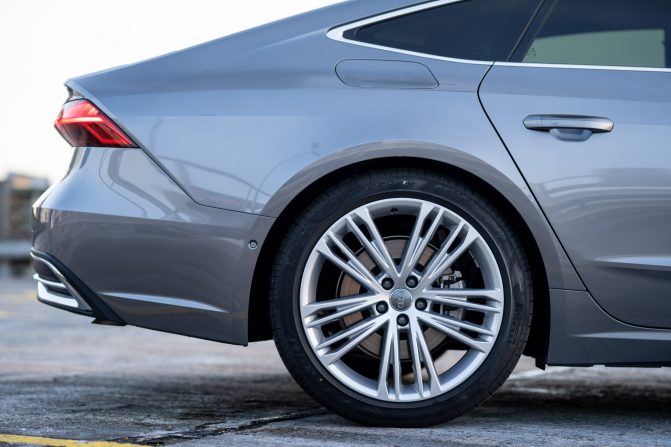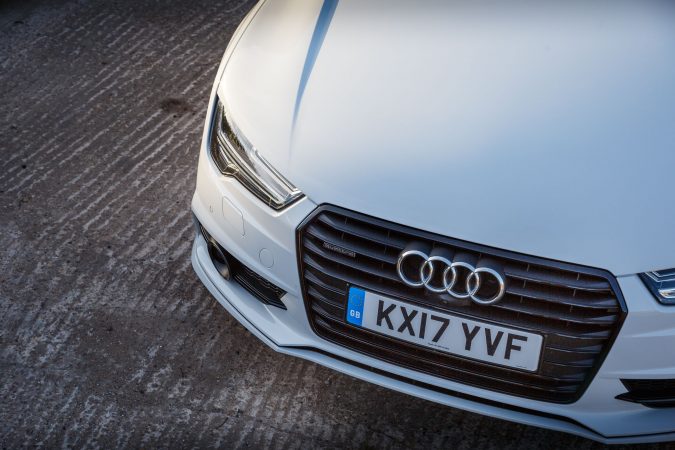The two letters that capture the heart of most performance car lovers? RS. Ever since Audi Sport (formerly quattro GmbH) unleashed the original RS2 Avant in 1994, the Ingolstadt brand has been crafting some of the most desirable performance cars on British roads. While BMW M and Mercedes-AMG might grab the flashier headlines, there’s something almost mystically appealing about Audi’s approach to performance: combining blistering pace with understated elegance and all-weather capability.
As we head into the latter part of 2025, the German brand’s stellar range also represents perhaps the most diverse and accomplished lineup of performance Audis ever offered to UK drivers. From compact hot hatches to thundering estates and SUVs, all the way to the electric performance models redefining what we expect from EVs, Audi’s current performance portfolio offers something for every petrolhead. With quattro all-wheel drive still forming the backbone of most models, these cars continue to deliver the confidence-inspiring traction that we value on our often wet and unpredictable roads.
In today’s post, we’re taking a short break from our car reviews as we get stuck into exploring the finest performance models currently donning the four rings, examining their capabilities, real-world driving experience, and value proposition in today’s market. We’ll also dive into the latest RS models, a mighty EV contender, and even preview a hotly-anticipated model set to come out latest this year.
Whether you’re considering a new purchase or looking at the increasingly appealing used market, this article will help you understand the strengths and nuances of Audi’s performance range.
Audi RS3 Sportback: The Hyper Hatch
First up, let’s touch on the RS3- long been touted as the gateway to Audi’s performance range, and the latest iteration continues to set the standard for compact performance cars. At its heart beats the now-legendary 2.5-litre five-cylinder turbocharged engine, producing 400bhp and 500Nm of torque- figures that would have seemed crazy in a hatchback even just a decade ago.
Performance Overview
The RS3’s headline figures remain impressive for 2025: 0-60mph in just 3.3 seconds and an electronically limited top speed of 155mph, which can be raised to 174mph with the optional performance package. What makes the RS3 special isn’t just the straight-line speed, but the character of that five-cylinder engine. With its distinctive warble, it offers a driving experience unlike anything else in its class.
The latest RS3 features Audi’s RS Torque Splitter, which can distribute power between the rear wheels, allowing for more precise handling and even controlled drifts in the right conditions. It’s a technological stroke of genius that transforms what could otherwise be a somewhat nose-heavy car into something genuinely playful.
According to TopGear, the RS3 even recorded the fastest Nürburgring lap time in its class last year, blitzing the BMW M2 with a time of 7m 33.12s.
Driving Experience
On British B-roads, the RS3 comes alive. Its compact dimensions make it easy to place, while the quattro system with torque splitter provides tremendous confidence even in poor conditions. The adaptive suspension does an admirable job of soaking up our notoriously uneven surfaces while still providing excellent body control when pushing on.
The steering may not offer the last word in feedback, but it’s precise and well-weighted. The real star of the show though remains that engine, which delivers its power with a smoothness and character that turbo four-cylinders simply cannot match. It’s particularly satisfying in the mid-range, where it pulls with relentless enthusiasm.
Cost: New vs Used
New, the RS3 Sportback will set you back around £59,650 for the base model, rising to around £70,000 with options like the ceramic brakes, sports exhaust, and driver assistance packages.
The used market offers better value as expected. Three-year-old examples of the current generation can be found from around £40,000 when looking at used Audis at ChooseMyCar.com. Previous-generation models represent even better bang for your buck, starting from approximately £30,000 for well-maintained examples with full service history.
Audi S4 Avant: The Sleeper Estate
Next on our list is arguably the quintessentially fast Audi: the S4 Avant, perfect for those that value understanded, and maybe less ostentatious, performance.. The 2025 model year saw the S4 receive a substantial update, returning to a petrol powerplant in the UK after a brief flirt with diesel power.
Performance Overview
The current S4 Avant packs a mighty 3.0-litre turbocharged V6 producing 354bhp and 500Nm of torque. While not as explosive as its RS counterparts, it delivers deeply impressive real-world performance: 0-62mph in roughly 4.7 seconds and an electronically limited 155mph top speed. The eight-speed Tiptronic automatic transmission shifts smoothly and quickly, though it lacks the engagement of a dual-clutch unit.
What makes the S4 Avant a stand out is its breadth of capability. It’s quick enough to entertain on the right road but settles down to become a supremely comfortable cruiser when needed. The 48V mild hybrid system helps with efficiency, returning a respectable 34.5mpg on the combined cycle according to official figures.
Practical Performance
The beauty of the S4 Avant lies in its duality. With 505 litres of boot space expanding to 1,510 litres with the seats folded, it’s a properly practical family car. The interior quality is outstanding, with materials and build that justify the premium price tag. The latest MMI infotainment system is slick and responsive, while the optional virtual cockpit digital instrument cluster remains one of the best in the business.
Cost: New vs Used
New, the S4 Avant starts at £54,995, with well-specified examples pushing £65,000. It’s not cheap, but considering the performance and quality on offer, it represents pretty reasonable value in today’s slightly inflated market.
The used market offers some bargains, particularly on the previous gen models. Three-year-old examples can be found from around £35,000, while five-year-old cars dip below £30,000. Given Audi’s solid reliability record and the S4’s relatively unstressed nature, these represent excellent value for money.
Audi RS e-tron GT: Electric Performance Redefined
With EVs like the Tesla Model S Plaid grabbing attention for their lightning speed, it would be remiss of us not to mention Audi’s flagship electric performance car, the RS e-tron GT. Sharing its underpinnings with the Porsche Taycan, this four-door coupe represents Audi’s vision for the future of performance.
Performance Overview
The numbers here are startling: 646bhp and 830Nm of torque from its dual-motor setup, delivering 0-62mph in just 3.3 seconds and a top speed of 155mph. What’s even more impressive is the way it delivers this performance. Unlike some electric performance cars, the RS e-tron GT doesn’t simply provide neck-snapping acceleration; it delivers its power with a sophistication that feels so thoroughly Audi.
The 93kWh battery provides a WLTP range of up to 283 miles, which translates to around 230-240 miles in real-world driving. Fast charging capabilities allow for a 5-80% charge in just 23 minutes when connected to a 350kW charger (infrastructure that’s becoming increasingly common across the UK’s major routes).
Driving Dynamics
Despite weighing over 2.3 tonnes, the RS e-tron GT handles with impressive agility. The low centre of gravity, courtesy of the floor-mounted battery pack, helps minimise body roll, while the standard-fit air suspension provides a comfortable ride even on the optional 21-inch wheels.
The four-wheel steering system also makes the car feel more nimble than its dimensions would suggest, particularly useful on winding British country roads. While it can’t match a true sports car for engagement, it offers a driving experience that combines impressive body control with long-distance comfort.
Cost: New vs Used
Take a deep breath because the RS e-tron GT doesn’t come cheap, with new models starting at £129,500 and well-specced examples pushing £150,000. However, as Audi’s flagship electric performance car, it offers tech and performance that justifies much of that premium.
The used market is still developing for these models, but early examples can now be found from around £90,000 with reasonable mileage. With electric technology evolving rapidly, depreciation has been somewhat steeper than for equivalent petrol models, we’ll let you decide if it’s worth the trade off.
Audi RS6 Avant: The Super Estate
Although we already covered the RS4 above, our final contentender is undoubtedly revered by most performance car lovers in the UK. Now in its fourth generation, the 2025 model brought subtle refinements to what was already a formidable package: it is of course the RS6 Avant.
Performance Overview
Under the bonnet sits a tremendous 4.0-litre twin-turbocharged V8 producing 621bhp and 800Nm of torque, slightly up from previous years. This translates to truly impressive performance: 0-62mph in approx. 3.4 seconds and a top speed of 174mph with the optional dynamic package. These are supercar figures in a car that can accommodate a family of five and their luggage.
The RS6’s quattro system now features a torque-vectoring rear differential similar to that found in the RS3, allowing for more dynamic handling despite the car’s considerable size and weight. The standard air suspension provides remarkable versatility, lowering at speed for better aerodynamics and raising for rough surfaces or steep driveways.
Living With A Super Estate
What earns the RS6 Avant rave reviews is its ability to handle our varied driving conditions with aplomb. From motorway cruising to B-road blasts, the RS6 feels composed and capable. The adaptive air suspension does a stellar job of controlling the car’s mass while still providing reasonable comfort, though it’s certainly firmer than non-RS models.
Inside, the RS6 combines sportiness with luxury. The RS sports seats hold you firmly in place during spirited driving but remain comfortable on longer journeys. The dual-screen infotainment system looks impressive and works well once you’ve acclimatised to it, though some may prefer physical controls for key functions.
Practical considerations haven’t been forgotten either. The 565-litre boot expands to 1,680 litres with the seats folded, making this a genuinely usable family car despite its performance credentials.
Cost: New vs Used
New, the RS6 Avant starts at £109,250, with well-specified examples easily pushing beyond £125,000. That’s serious money, but considering the breadth of the car’s capabilities, many owners consider it justifiable.
The used market offers some interesting options. Three-year-old examples of the current generation can be found from around £75,000, representing significant savings. Previous generation models offer even better value, with good examples available from £45,000-£55,000 depending on age, spec and condition.
Future Performance: The Upcoming Audi RS Q6 e-tron
Looking ahead, one of the most anticipated additions to Audi’s performance lineup is the RS Q6 e-tron, set to arrive sometime this year and following on from the Q6 e-tron. This all-electric performance SUV is Audi’s highly publicised forrary into electrifying its RS range.
Based on initial info from Audi, the RS Q6 e-tron will feature a dual-motor setup producing approximately 600bhp, with 0-62mph expected to come in under 4 seconds. The 100kWh battery should provide a WLTP range of around 300 miles, addressing the range anxiety that still concerns some potential EV buyers.
What makes the RS Q6 e-tron a potential game-change is that it’s built on Audi’s new PPE (Premium Platform Electric) architecture, developed specifically for electric vehicles. This should address some of the compromises found in EVs based on adapted internal combustion platforms.


